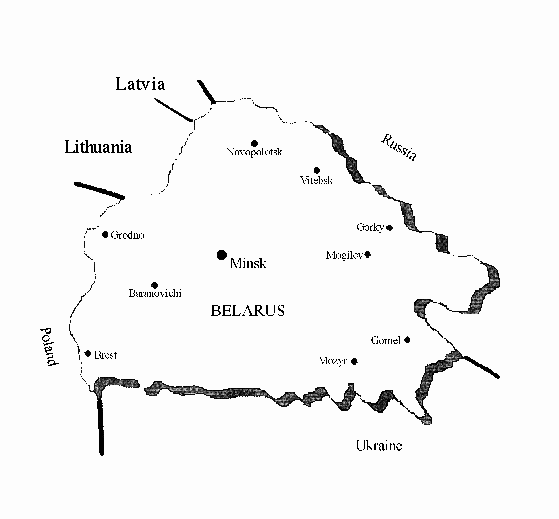
Women-Physicists in Belarus
Larissa Svirina1, Galina Zalesskaya2, Iryna Miadzvedz3
1Institute of Physics NASB
2Institute of Molecular and Atomic Physics NASB
3Belarussian State University
CONTENT
1. History of the education in physics in Belarus.
2. Structure of the education in physics in Belarus
3. Women-physicists in science and education
National Academy of Sciences of Belarus.
Higher education and the secondary school.
4. Some statistical data from questionnaires
5.Conclusions
BELARUS

Republic of Belarus is situated in Eastern Europe. It is bounded by Russia, Ukraine, Poland, Lithuania, and Latvia. Its area is 207600 sq. km, population exceeds 10 million. Largest towns are Minsk (capital, 1.7 million population), Gomel, Brest, Vitebsk, Grodno and Mogilev. Before the revolution of 1917 Belarus was a part of the Russian Empire, from 1919 to 1991 it was one of the sovereign republics of the Soviet Union. As an independent state the Republic of Belarus was formed in Dec 1991 after desintegration of the Soviet Union. Belarus is a founder-member of the United Nations Organization.
1. History of the education in physics in Belarus.
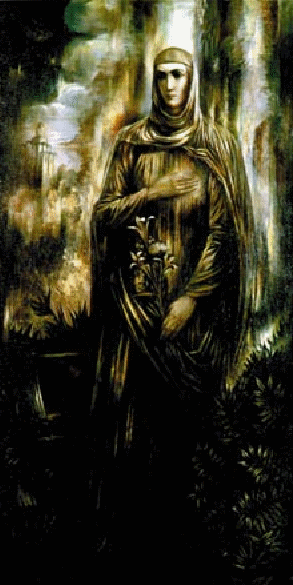 Since ancient times women of Belarus have been characterized
by their aspiration for education and enlightening activities. It is
impossible to imagine the cultural and spiritual dawning of the
Eastern Slavs without Efrossinya Polotskaya lived from 1112(?) to May
23, 1173. Her real name was Predslava, she was the daughter of Prince
Georgiy Vseslavich of Polotsk. At the age of 12 she became a nun,
taking the name Efrossinya. She founded convents and churches with
the first scriptoria, which provided books for the schools she had
set up. Efrossinya Polotskaya was one of the first woman politicians,
diplomat and peacemaker.
Since ancient times women of Belarus have been characterized
by their aspiration for education and enlightening activities. It is
impossible to imagine the cultural and spiritual dawning of the
Eastern Slavs without Efrossinya Polotskaya lived from 1112(?) to May
23, 1173. Her real name was Predslava, she was the daughter of Prince
Georgiy Vseslavich of Polotsk. At the age of 12 she became a nun,
taking the name Efrossinya. She founded convents and churches with
the first scriptoria, which provided books for the schools she had
set up. Efrossinya Polotskaya was one of the first woman politicians,
diplomat and peacemaker.
Afterwards many women of Belarus gave a good account of themselves in literature, botany, business, medicine, and other fields. Physics was not well developed in those days and it was exclusively "male" profession.
Fig1.
Efrossinya Polotskaya
Belarus gave the wold lots of famous physicists, which is the evidence of the high intellectual potential of our country. Among them are Ya. Narkevich-Yodko (1847-1905, born in Minsk region) who was famous by investigations in electricity, K. Tchaxovitch (1832-1902, born in Oshmyany) was famous in spectroscopy, he observed spectra of the excited ions, I. Yarkoyski (1844-1902) from Vitebsk region, suggested the idea of radioactive decay of atoms, N. Yastrebski (1808-1874, born in Rechica region) the author of "Course of practical mechanics"), K. Shyldar (1785-1854) from Vitebsk region together with P. Shyleng, constructed an electrical telegraph, G. Vrubleyski (1845-1888), professor of Krakov university found the critical temperature of liquefaction of gases, A . Sadoyski (1859-1929, born in Vitebsk) is known in works on optics and electromagnetism, V.Ceraski (1849-1925) from Slutsk found the lowest bounder of the temperature of the Sun, G. Minkoyski (1864-1909, born in Minsk region) is famous in special relativity, A. Gershun (1868-1915, born in Grodno region) created a series of optical instruments, V. Goldanski (1923, born in Vitebsk) and A. Migdal (1911, born in Lida) are famous in quantum theory of field and matter, Ya. Khanin (1929, Vitebsk) is known in quantum electronics, A.Brysh (1917, Minsk) is famous in nuclear physics.
Nobel prizes were awarded to Shaldan Li Glashoy (Glukxovskii) in 1979 for the theory of weak and electromagnetic interaction, and to Ilya Prigogine in 1977 for the works in synergetics.
The revolution of 1917 played the key role in formation of social and gender equality making higher education free and available to all sections of the population and repealing the prohibition against "male" professions, which was reflected in a number of legislative acts. Today Belarus is a land of complete literacy where 28% of population have a higher education, half of which are women.
As main milestones in the formation of science and education (including physics) in our country, one should consider to be the opening in 1921 of the Belarussian State University (BSU), where at the physico-mathematical department (later the departments of physics and radiophysics) it became possible to obtain the qualification of a physicist, as well as the establishment in 1929 of the Academy of Sciences of Belarus which became the center of scientific research and training of highly qualified specialists.
Today Belarus boasts of eight universities awarding a diploma in physics.
2. Structure of the education in physics in Belarus
In Belarus the study of Physics as a separate subject begins in the 7th year of a secondary school, i.e. at 12-13 years age, Before in 5th and 6th years of the school, the schoolboys get acquainted rather sketchy only with some elements of the physical knowledge within the framework of an integrated subject "Universe". Then Physics is studied up to finishing a complete secondary school, or after its 9th year in lyceums and special secondary technical and industrial schools. The incomplete (nine-years) general secondary education in Belarus is mandatory for all children capable to visit school on their physical and mental conditions.
For the last 10 years in Belarus the important work on modification of the programs and structure of all system of education is carried out. The objective is to adapt the education to a world level and to more fully take into account the new conditions arisen. The peculiarity of this work in Belarus is that it is being carried out considerably slower and more circumspectly, than in other countries of the former Soviet Union. However, the physics priority and prestige have also decreased in Belarus comparing the level that was before the "Perestroika" in the Soviet Union.
Time evolution of the popularity of Physics among young is illustrated by Fig.2, where the amount of students of physical faculty of the Belarus State University (BSU) is represented (radiophysical faculty is not included).
In our country, the work on transformation of the educational system (frequently called as its perfecting, what is not always true) is carried out by the Ministry of Education. Teachers of high schools and professors of special and higher educational institutions are widely engaged in the work. All physicists of the country participate in the work.
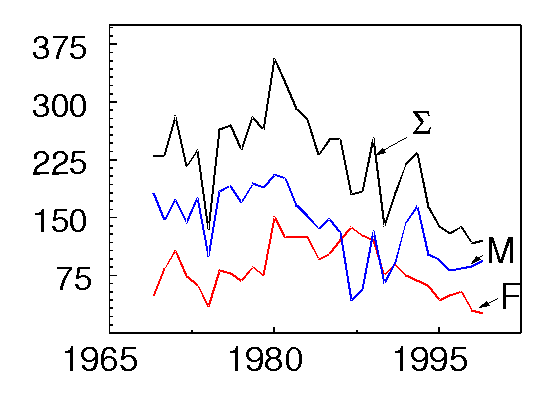
Fig.2. Graduates
from the physical faculty of BSU.
Speaking about the modifications in the system of physical education occurred in Belarus for the last 10 years, it is necessary to note, first of all, that the number of academic hours used for the physical education in general secondary schools has been significantly (up to 30 %) reduced. Certainly it resulted in a drop of volume and depth of physical material mastering. Alongside with it however, a number has considerably increased of specialized schools and classes with the profound Physics study. Lyceums and colleges of the physical profile have arisen ensuring preparation in Physics of essentially higher level, than it is in general secondary schools. Professors and senior lecturers of universities are frequently recruited to teach Physics in such educational institutions. Many lyceums are created directly at universities. As a rule, the pupils of such lyceums are young boys and girls, who have, shown good knowledge of physics at various Olympiads, student's conferences and at pupil research schools.
Physical Olympiads at region and republican levels are annually carried out in Belarus for already more than 40 years. The last 8 years the conferences also take place, at which the pupils of higher classes make their reports on results of the experiments or theoretical researches. Also research schools of the pupils and teachers work, where the possibility is submitted to their participants to carry personally their experiments on physics.
Belarus, as NIS, has already participated in 7 international Olympiads and 10 Tournaments, always showing good results. At the Olympiad in Italy, 1999, all 5 Belarus participants have got medals, winning 1 gold, 3 silver and 1 bronze medal. This year the Belarus teams have won the bronze medal at 13th Tournament in Helsinki and 4 medals (1 gold, 2 silver and 1 bronze) at Olympiad in Turkey.
Olympiads and other measures of a competitive character undoubtedly raise the prestige of Physics among youth. On the other hand, they allow to reveal and to assist in further development of the most capable young men and girls inclined to devote themselves to physics. Afterwards mainly this contingent composes pupils of lyceums working at universities and students of physical and technical faculties.
Provided their sufficient preparation on Physics and desire, the graduates of secondary educational institutions can continue their physical education at universities and physical engineering high schools both in Belarus or in Russian Federation according to the contract within the framework of the Union of Russia and Belarus.
There are eight universities in Belarus awarding a diploma in physics.
To obtain a diploma, besides passing exams, a student has to carry out scientific research summarized in a manuscript and defend its results before the commission. Thus, the diploma on higher education in our country, in general, corresponds to Master's degree in other countries.
Every year in Belarus about 800 people, of which about 30% are women, obtain such a qualification. Fig.2. shows the regional distribution of the amount of students graduated from the physical faculties in 2001.
Fig.3. GRADUATES FROM PHYSICAL FACULTIES 2001
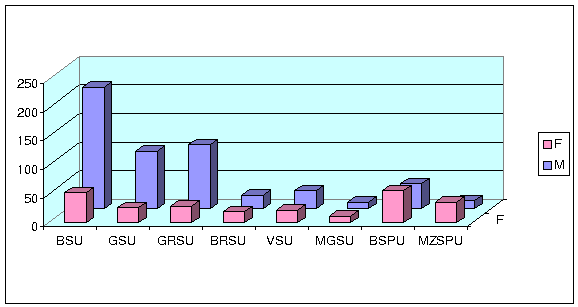
|
|
BSU |
GSU |
GRSU |
BRSU |
VSU |
MGSU |
BSPU |
MZSPU |
|
F |
52 |
26 |
29 |
19 |
22 |
11 |
56 |
36 |
|
M |
213 |
101 |
112 |
24 |
32 |
12 |
44 |
14 |
|
% |
19 |
20 |
21 |
44 |
41 |
48 |
56 |
72 |
|
S |
265 |
127 |
141 |
43 |
54 |
23 |
100 |
50 |
- Belarussian State University, GSU - Gomel State University, GRSU - Grodno State University, BRSU - Brest State University,
VSU - Vitebsk State University, MGSU- Mogilev State University, BSPU - Belarussian State Pedagogical University, MZPSU - Gomel State Pedagogical University.
Further education in physics with awarding Candidate's degree in physics and mathematics (Ph.D) is continued at the post-graduate courses of the Academy of Sciences or at those of the state universities. Post-graduate course admits persons having a diploma of higher education. The post-graduate student keeps to an individual plan that provides advanced study of general science and special courses, passing certain candidate examinations in the subject of specialization, foreign language, philosophy, and a test in the "Fundamentals of information technologies". To obtain Candidate's degree (Ph.D), one has to carry out scientific research, publish the results in scientific journals (about 10 papers), systematize them, prepare in the form of a dissertation and defend it.
The highest-level degree in Belarus refers as "Doctor of Science in Physics and Mathematics ". To be awarded Doctor's degree in physics and mathematics, it is necessary to make original investigations confirmed in about 30 publications, write a dissertation (when working at the institute or attending doctoral courses) and defend it. Both Candidate's and Doctor's degrees are awarded by the specialized Council for Defense of Dissertations whose decision is approved by the State Supreme Accreditation Committee of the Republic of Belarus.
There are eight Scientific Councils for Defense of Dissertations that award Candidate's and Doctor's degrees in different specializations in physics.
Every year in Belarus 34 Candidate's and 13 Doctor's degrees in physics and mathematics are defended, of which 7.2 (21%) and 0.6 (5%), respectively, are those of women (averaged over 1997-2001). The data for the last five years, as well as the total number of candidates and Doctors in Belarus are represented in Fig.4.
|
Scientific degree |
Sex |
1997 |
1998 |
1999 |
2000 |
2001 |
S |
|
Candidate |
F |
7 |
4 |
6 |
7 |
12 |
36 |
|
|
M |
33 |
25 |
19 |
27 |
30 |
134 |
|
Doctor |
F |
1 |
0 |
1 |
1 |
0 |
3 |
|
|
M |
13 |
9 |
12 |
22 |
7 |
63 |
Fig.4 The number
of Candidate's and Doctor's degrees.
There are 376 Doctors and 1391 Candidates in different physical specializations, of which 24 (6%) and 322 (23%) are women.
Professorial status is conferred on a doctor of physics and math with a long record of teaching or on that who has prepared at least five candidates of science. Corresponding-member and Academician status is conferred on a doctor of physics and math, with extra advantage scientific achievements. There are 13 academicians and 14 corresponding members in Belarus of which no any one woman.
3. Women-physicists in science and education
In our country the scientific research in physics is carried out in 10 institutes of the National Academy of Sciences of Belarus (NASB) and in higher educational establishments.
The top research institutes in Belarus with large physics components are: the Institute of Physics of the National Academy of Sciences of Belarus (NASB), the Institute of Molecular and Atomic Physics NASB, the Institute of Solid State and Semiconductor Physics NASB, the Institute of Electronics NASB, Belorussian State University, Gomel State University, Grodno State University.
There are no women in the top two management levels of each of these institutions.
The principal achievements of women in physics cover such fields as laser physics, nonlinear dynamics of laser and optical systems, investigations of the processes of relaxation of complex molecules in different phase states, atomic and molecular spectroscopy, biophysics, the physics of the solid body, crystal optics, thermo physics, nuclear physics, etc. Women take an active part in international conferences, publish their works in home and international journals and monographs.
National Academy of Sciences of Belarus.
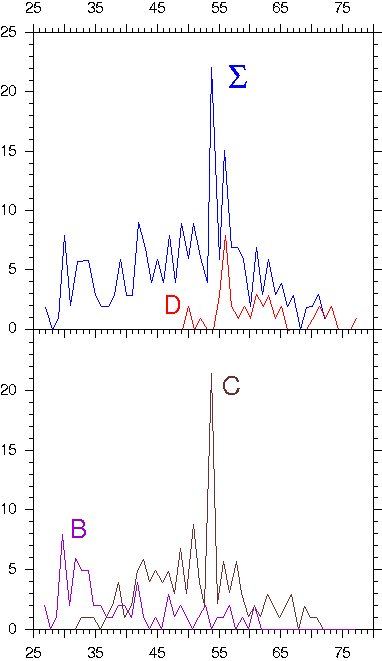
According to the data of the Center of monitoring the migration of
the scientific-pedagogical staff, today the total number of
researchers engaged in the field of physics at the NASB institutes
amounts to 1490, of which 504 (33%) are women. This is a fairly high
index, although it is lower than the average number of
women-researches working at the NASB -- 48%. Women account for 7% of
doctors and 14,5% of candidates of sciences. As to the age
distribution, women under 30 constitute 10.7% of the total number of
women-researches, at the age of 30-39 - 17.3%, 40-49 - 28%, 50-59 -
27%, and over 60 - 6.5%. Thus, we can speak of certain "ageing "
of science.
Fig.5 Age distribution of the research workers at the Institute of Physics of NASB: S- total number, D- Doctors, C- Candidates, B- without scientific degree.
Such a distribution is also characteristics of men and, accordingly, to the whole physics department of the NASB. The "ageing of science" problem is illustrated by Fig.5, where the age distribution of the
research workers at the Institute of Physics of NASB is represented. Such a distribution is also characteristics of men and, accordingly, to the whole physics department of the NASB.
At the IP NASB there are 113 Candidates, of which 13 (12%) are women and 41 Doctors, of which 4 (10%) are women, 64 researchers, of which 13 (20%) women have not scientific degree. The total number of researchers is 252 of which 24 (23 men and 1 woman) are Ph.D students.
Women-physicists almost twice less quit their job and twice more often visit foreign countries (mainly to participate in conferences) than women of other specialities.
In the last five years (1996-2000), 32 post-graduate students, of which 5 (15.6 %) are women, have completed post-graduate courses of NASB with the presentation of the dissertation for the Candidate's degree.
Higher education and the secondary school.
In our country, physics as general education subject is taught in 27 higher schools. The characteristic of the higher school lectures is well represented by the data on the number of women-physicists working at the departments of physics of three higher educational establishments: BSU -- 18 women (17% of the whole training personnel), of which 1 is a Doctor of Science, 11 are PhD; Gomel SU -- 14 (21%), of which 1 is a Doctor of Science, 4 are PhD, and at the Belarussian State Polytechnical Academy (BSPA) -- the largest in Belarus technical higher educational establishment -- 25 (28%), of which 12 are PhD.
The regional distribution of the amount of lectures at the physical faculties is shown in Fig.6.
Fig.5
Age distribution of scientific workers of the IP NASB; S
is the total number, D is the number of Doctors , C - Candidates,
and B - without degree.
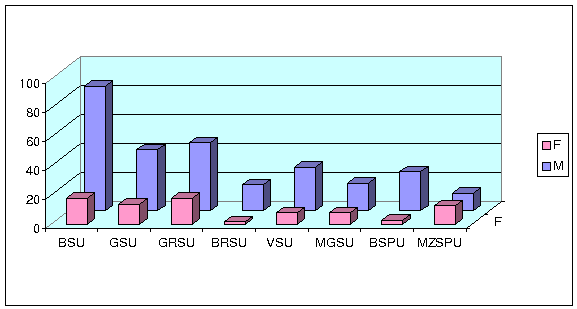
|
|
BSU |
GSU |
GRSU |
BRSU |
VSU |
MGSU |
BSPU |
MZSPU |
|
F |
18 |
14 |
18 |
2 |
8 |
8 |
3 |
13 |
|
M |
86 |
42 |
47 |
18 |
30 |
19 |
27 |
12 |
|
F% |
17 |
21 |
28 |
10 |
21 |
30 |
10 |
52 |
|
TOTAL |
104 |
66 |
65 |
20 |
38 |
27 |
30 |
25 |
Fig.6.
The number of women-physicists engaged in industry, when they also acquire additionally an engineer's qualification, is relatively small.
4. Some statistical data from questionnaires
a) Below the results are presented of questioning of 97 women-physicists who have received the diploma in physics and working as researches in scientific institutions and as teachers of physics in the secondary schools. The following age groups are among respondents: till 30 years - 3%, 30-39 years -22%, 40-49 years - 36 %, 50-59 years - 30 %, and more than 60 years - 9 %.
Among interrogated there are scientific researchers (31 %), teachers of secondary schools (51 %), the lectures of high school - 6 %, other women work as engineers, programmers, or are engaged in publishing.
The Doctor's degree received 10 %, Candidate's degree - 26 %.
Progressive development of physical researches in any country is impossible without the national highly professional scientific researchers, whose education begins at the secondary school.
The majority of the interrogated women - 60 % believe that the physics is taught at school as well as other subjects, some of them (18 %) think, that the teaching of physics at school is better than the other subjects. The major part of interrogated women (92 %) has chosen physics as profession at school. This choice was influenced by the interest to the subject (75 %), by influence of teachers (31 %) and by parents (8 %).
The most of them (82 %) are married and have children (76 %). These factors, in the opinion of 33% and 50 %, respectively, have decreased their professional activity because of the lack of time, impossibility to work a lot, the opinion of colleagues that if you have children, your professional activity is not effective enough.
The most of women (81 %) think that the improvement of a situation of women in physics is necessary. As the reasons for giving up the professional activity were recall low salary, reduction of staff, inadequate attitude on the men-colleagues, the employees and chiefs, unequal rights and opportunities for men and women, absence of prospects.
Despite of significant difficulties in their career and life 64 % of questioning women would choose physics again.
b) Physicists and humanitarians
Here some results are represented from the report of the program "Woman's Health". which are based on the statistical analysis of 200 questionnaires.
The difference between physicists and humanitarians in social life is illustrated by Fig.7. As follows from Fig.7 physicists have much more problems in work, than humanitarians.
The results of interrogation have shown, that " the difficulties in career" and " gender inequality" physicists feel much more strongly than humanitarians. Probably it is because of the prevalence of men in the field of natural sciences, which render very strong resistance to the women trying to make career in this traditionally man's sphere. More often men apply psychological pressure on women, sometime they use also another receptions (concealment of information, administrative pressure, understating of material compensation, etc.). Physicists much more fear " to lose a job " and " to find another suitable job". Humanitarians are more mobile and sure in their opportunities.

Fig.7.
In the other spheres of life the answers have shown that:
-- Physicists much more concern about "material well-being "
-- Humanitarians feel themselves much better in "sex" than physicists.
-- Analogous situation takes place in "self-realization" and "appearance".
--Physicists suffer more from the lack of friends and interesting people
The analysis of the filled questionnaires has shown physicists have much more problems in all substantial spheres of life, than humanitarians. This fact, probably, testifies the best adaptation of humanitarians to the existing conditions.
5.Conclusions
In our country, the problems of women in the field of physics have not been studied; we hope that the activities of our group will permit us to begin such investigations. Many Belarussian women have chosen physics for their profession. The chief problem of women physicists in Belarus, as in other countries, is the relatively slow promotion rate and the low probability of occupying a leadership position.
A woman's career in physics will be more successful in our country if the level of industrialization of housekeeping is raised. Women, as a rule, traditionally take care of brining up children, look after the old parents and practically for all housekeeping (purchase of products, cooking, cleaning, washing, and sometimes cultivating and preserving vegetables and fruit). Because of the relatively low salary far from each family can use the system of household services (to eat in restaurant, to have a nurse, etc.) or even afford modern domestic appliances (vacuum cleaner, dishwashing machine, clothes washer, etc.) facilitating home work.
Labour legislation of Belarus defends the rights of women. At the state enterprises there are mostly permanent positions than temporal ones. When a woman is gong to have a baby, she has two-month paid holiday before the birth and remains her position for 3-year with partially paid holiday for childcare.
Nevertheless, as the analysis of interrogation has shown, at the institutions, women - physicists meet a various sort of discrimination (less equipment, size of office, salary, psychological pressure from the colleagues - men, etc). One of the key measures favoring a more comfortable existence of a woman in physics would be the legislative regulation of gender balance at the institutional administration, scientific councils, financial agencies, etc.
However in our country (as well as in other countries) all leading positions, both in government (in parliament there are 10% of women) and in scientific and educational establishments are occupied by men. So at present it is hardly ever possible to adopt such laws (officially there are not gender problems). One of the way of improvement of the institutional climate and decrease the discrimination of women is to create the non-state women organizations (commissions, work groups). It can be realized in the framework of Belarus Physical Society.
Sources of data:
Belarussian Women as Seen Through Era, National report of UNDP, Minsk, 1997.
Higher education in Belarus, brief guide. Ministry of Education of the Republic of Belarus; National Institute of Higher School affilated with the Belarussian State University, Minsk, 1998.
Annual report of the Ministry of Education of the Republic of Belarus. Minsk, 1995-2000.
Attectaciya, 2001, No1, p.29-31.
Annual Report on Activity of the National Academy of Sciences of Belarus, Minsk, 2000.
Personal correspondence.